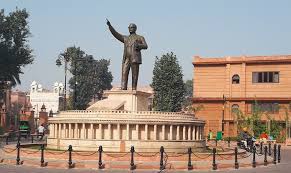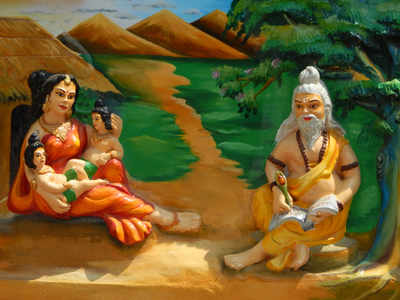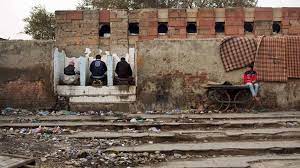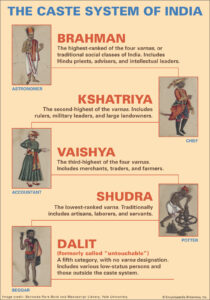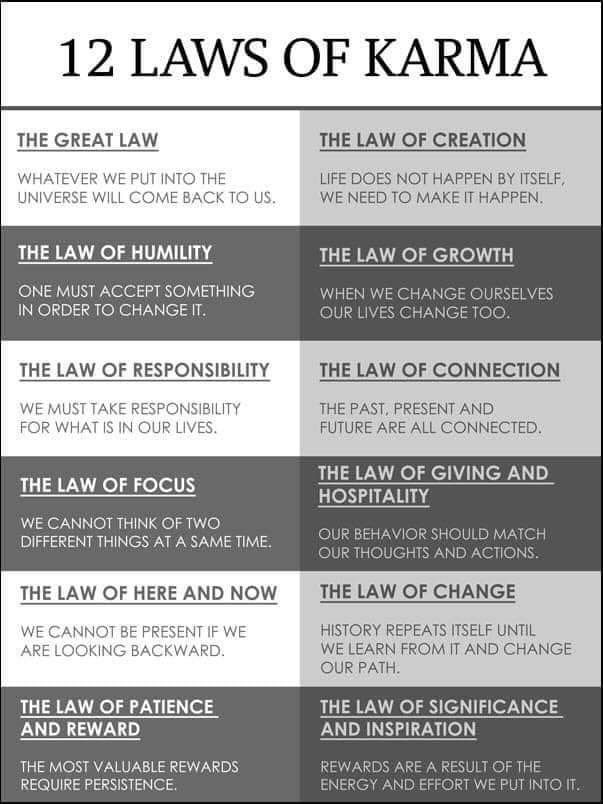The Lot of the Exploited, Discriminated and Oppressed (Part 1)
TRANSCEND MEMBERS, 13 Dec 2021
Prof Hoosen Vawda – TRANSCEND Media Service
Is It Predestination, Karma, or Hedonistic Colonial Subjugation by People of Aryan Origins? An Odyssey of Generational Suffering of Humanoids of Colour
8 Dec 2021 – It is obvious to every humanoid on planet Earth, that the good Lord, or biological and sociological evolutions have made everything in pairs: Night-day, earth-sky, animals-humans, male-female, land-water, majestic mountains-flat plateaus, macroscopic, microscopic, carnivores-herbivores, life-death, angelic-demonic, good-bad, fair skin humanoids-dark skin humanoids, poor-rich, educated-illiterate, honesty-thievery, corrupt-pious, and the list goes on. This bipartite arrangement, like government and opposition is evident throughout the universe as well in the form of suns and blackholes. It is eminently clear that everything is coupled and the hierarchy of things is so designed, in order to play games with humanoids, from the Biblical times of Adam-Eve, as well as their progeny, Caine and Abel, at a macro level, to gram positive and gram negative bacteria at a nano level.
In the classics, the Hellenistic religious philosophy, states that one day, Apollo, as a young man, the future the sun god, asked his father Zeus, if he could take the chariot containing the Sun, driven by Zeus’s powerful thoroughbred steeds, on the daily rounds circumnavigating the Earth, bringing about day with the sunrise and upon return, it would be sunset and night, when the horses were rested and the Sun, “put to sleep”. Zeus warned Apollo to be extremely careful for, he could easily lose control of the chariot driven by the powerful steeds, with disastrous consequences for Earth. However, Apollo, as any young son would, insisted that he will be careful and he took off with the chariot around Earth, much to the great consternation of Zeus, as any teenager, driving his father’s “Mercedes Brabus 950”[1]. While executing this task, Apollo soon realised that, the steeds were extremely fast and he was losing control of the chariot, with the Sun in the back. The result was indeed disastrous. Apollo lost total control and the sun in the chariot was brought close down to the surface of the Earth in the peri-equatorial region. This resulted in the land in the regions being burnt resulting in arid dessert land, with the humanoids becoming dark in colour from the fierce heat of the Sun,. Therefore, due to the carelessness of the enthusiastic and youthful Apollo, the dark-skinned races emerged. This is the mythological explanation for the origins of the dark-skinned people of colour, according to Greek religious doctrines, at the time, while modern day humanoids classify this as legends, based on our, present scientific knowledge and understanding.
If the ancient Biblical narrative is reviewed, Prophet Noah, who was instructed by the Lord of the Old Testament to construct an ark of specified dimensions in which he must take a pair of animals, of opposite genders, an instruction, which he obediently carried out. One of Prophet Noah’s son called Ham, displeased him during the time on the ark while the great deluge was in progress. Upon the landing of the ark when the waters of the great deluge receded, Ham went off independently and was responsible for the emergence of the dark-skinned race which were the progeny of his cursed son Ham. Here again, Christianity, has justified the discrimination against people of colour, based on a biblical narrative in the Old Testament.
This paper analyses the plight of the dark-skinned humanoids, throughout the world, to demonstrate the discrimination, abuse, oppression and even murder without accountability of people of colour over the eons of time. The author examines the following groups of phenotypically different humanoids, all having one common denominator of dark skin, which denigrates them and separates them from the fair skinned humanoids, who in turn oppresses them in history and even in present day in the 21st century, globally.
- The Scheduled Castes in India
- The Black people of the whole of Africa
- The Indigenous Maoris of New Zealand and Pacific Islanders
- The Indigenous aborigines of Australia
- The Indigenous tribes of Amazonia
- The First Nations of Canada
- The Indigenous Tribes of North America
- The African Americans of present-day United States
Similarly, in Hinduism, there is overt discrimination against people of colour, especially towards the dark-skinned Indians, given the mythological and socio-religious foundations in two areas. Firstly, in the holy Hindu scripture, the Ramayana, narrates the war waged by Lord Rama, assisted by Lord Hanuman, the King of the non-human primates, the monkeys, against the evil King of Lanka, what is presently called Sri Lanka. This campaign was waged because King Ravana became desirous of acquiring, Lord Rama’s wife, Sita Devi and subsequently devised a nefarious plan to abduct Sita Devi, in which act he was successful. The ensuing war resulted in Lord Hanuman igniting a fire in the city of King Ravana, causing the populace to become dark skinned and classified as an evil lot by the north Indians who are fair skinned, giving rise to the Proto Indo-European stock theory according to the Prime Minister Narendra Damodardas Modi, who is rewriting the genealogical history of “Out of India”, aided by his team of selected anthropologists. Thus, the Ramayana, as the revered Hindu holy scripture sets another religious angle for racial discrimination against dark skinned populace, by the superior Aryan stock, in the Indian sub-peninsula. This is the special brand of “Indian Apartheid” based on the narrative of the Ramayana. Nevertheless, while Valmiki[2] who scornfully states in the Ramayana, that King Ravana was a villain and a barbarian who abducted Sita Devi, various people in India even today are making fraudulent attempts to tarnish the virtuous name of King Ravana with the intention of sinking the history of Sri Lanka associated with him.[3] Valmiki is celebrated as the harbinger-poet in Sanskrit literature. The epic Ramayana, dated variously from the 5th century BCE to first century BCE, is attributed to him, based on the attribution in the text itself. He is revered as Ādi Kavi, the first poet, author of Ramayana, the first epic poem. The Ramayana, originally written by Valmiki, consists of 24,000 shlokas and seven cantos (kaṇḍas).
The presence of the fair skinned, superior race of Aryans, who were considered good people, based on Valmiki’s Ramayana was a philosophy, which the Third Reich under Adolph Hitler propagated with his eugenics experiments in order to create a superior fair skinned Aryan race, implying that every humanoid who was dark skinned is impure and inferior. This is part of the justification for maltreating and discriminating against the dark-skinned Dalit population in India, apart from another religious reasons for the brutal atrocities committed against the Dalits, the Untouchable humanoids of modern-day India.
The second aspect of discrimination and apartheid in India has its foundations on the caste system, which is based on an individual’s actions or duties also called dharmas, which determines by divine pre-destiny, as to which caste an individual will be born in the next cycle of birth or reincarnation, according to Hinduism. If ones’ actions in the past reincarnation was evil, with no good deeds, then that person will be born in a lower caste or even as an animal. Therefore, the Dalits are predestined to suffer in the present reincarnation, in order to be literally punished for their sins and the group as a whole, need to be mistreated by the higher caste communities in the socio-political hierarchy of things.
The term Dalit is derived from Sanskrit, romanised; dalita meaning “broken/scattered”, is a name for people belonging to the lowest stratum castes in India, previously characterised as “untouchable”.[4] Dalits were excluded from the four-fold varna system of Hinduism as illustrated in the graphic, and were seen as forming a fifth varna, also known by the name of Panchama. Dalits now profess various religious beliefs, including Hinduism, Buddhism, Sikhism, Christianity, Islam and various other belief systems. “Scheduled Castes” is the official term for Dalits as per the Constitution of India.
The term Dalit is a self-applied concept for those called the “untouchables” and others that were outside of the traditional Hindu caste hierarchy.[5] Economist and reformer Mr Bhimrao Ramji Ambedkar (1891–1956)[6] said that untouchability came into Indian society around 400 CE, due to the struggle for supremacy between Buddhism and Brahmanism (an ancient term for Brahmanical Hinduism).[7] Some Hindu priests befriended untouchables and were demoted to low-caste ranks. Eknath, another excommunicated Brahmin, fought for the rights of untouchables during the Bhakti period.
In the late 1880s, the Marathi word ‘Dalit’ was used by Mahatma Jotiba Phule for the outcasts and Untouchables who were oppressed and broken in the Hindu society.[8] This word was repurposed in 19th century Sanskrit to mean “a person not belonging to one of the four Brahminic castes”.[9] It was perhaps first used in this sense by Pune-based social reformer Jyotirao Phule[10], in the context of the oppression faced by the erstwhile “untouchable” castes from other Hindus.[11] The term Dalits was in use as a translation for the British Raj census classification of Depressed Classes prior to 1935 but as never shown to people it was recently put in use since the past Orissa Parliament renamed SC/ST to Dalits. It was popularised by Ambedkar, himself a Dalit,[12] who included all depressed people irrespective of their caste into the definition of Dalits.[13] It covered people who were excluded from the four-fold varna system of Hinduism and thought of themselves as forming a fifth varna, describing themselves as Panchama.[14] In the 1970s its use was invigorated when it was adopted by the Dalit Panthers activist group.[15]
Socio-legal scholar Oliver Mendelsohn[16] and political economist Marika Vicziany[17] wrote in 1998 that the term had become “intensely political … While the use of the term might seem to express appropriate solidarity with the contemporary face of Untouchable politics, there remain major problems in adopting it as a generic term. Although the word is now quite widespread, it still has deep roots in a tradition of political radicalism inspired by the figure of B. R. Ambedkar.” They went on to suggest that its use risked erroneously labelling the entire population of untouchables in India as being united by a radical politics.[18] Anand Teltumbde[19] also detects a trend towards denial of the politicised identity, for example among educated middle-class people who have converted to Buddhism and argue that, as Buddhists, they cannot be Dalits. This may be due to their improved circumstances giving rise to a desire not to be associated with the what they perceive to be the demeaning Dalit masses.[20]
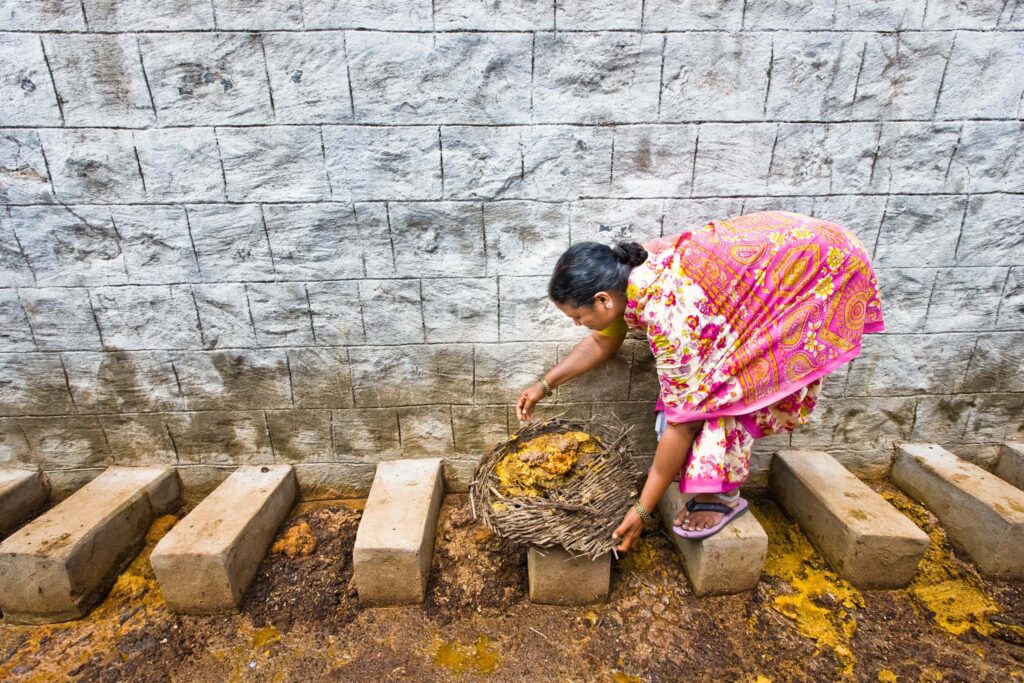
Dalit lady removing faeces from open public toilets in India: Note the absence of any protective attire.
Presently the “Scheduled Castes” is the official term for Dalits in the opinion of India’s National Commissions for Scheduled Castes (NCSC), who took legal advice that indicated modern legislation does not refer to Dalit and that therefore, it says, it is “unconstitutional” for official documents to do so. In 2004, the NCSC noted that some state governments used Dalits rather than Scheduled Castes in documentation and asked them to desist.[21] The term Harijan, or ‘children of God’, was coined by Narsinh Mehta, a Gujarati poet-saint of the Bhakti tradition, to refer to all devotees of Krishna irrespective of caste, class, or sex.[22] Mahatma Gandhi, notably an admirer of Mehta’s work, first used the word in the context of identifying Dalits in 1933. Ambedkar disliked the name as it placed Dalits in relation to a greater Hindu nation rather than as in an independent community like Muslims. In addition, many Dalits found, and still find, the term patronising and derogatory, with some even claiming that the term really refers to children of the Devadasis.[23] When untouchability was outlawed after Indian independence, the use of the word Harijan to describe ex-untouchables became more common among other castes than within Dalits themselves.[24] In 2017, Supreme Court of India noted calling people Harijan was offensive.[25] In Southern India, Dalits are sometimes known as Adi Dravida, Adi Karnataka, and Adi Andhra, which literally mean First Dravidians, Kannadigas, and Andhras, respectively. These terms were first used in 1917 by Southern Dalit leaders, who believed that they were the indigenous inhabitants of India.[26] Scheduled Caste communities exist across India and comprised 16.6% of the country’s population, according to the 2011 Census of India.[27]
Dalits have had lowest social status in the traditional Hindu social hierarchy, but James Lochtefeld, a professor of religion and Asian studies, said in 2002 that the “adoption and popularization of the term Dalit reflects their growing awareness of the situation, and their greater assertiveness in demanding their legal and constitutional rights”.[28] Regarding their employment, in the past, the Dalits were believed to be so impure that upper caste Hindus considered their presence to be polluting. The “impure status” was related to their historic hereditary occupations that caste Hindus considered to be “polluting” or debased, such as working with leather, disposing of dead animals, manual scavenging, or sanitation work.[29] Forced by the circumstance of their birth and poverty, Dalits in India continue to work as sanitation workers: manual scavengers, cleaners of drains, garbage collectors, and sweepers of roads. As of 2019, an estimated 40 to 60 per cent of the 6 million Dalit households are engaged in sanitation work. The most common Dalit caste performing sanitation work is Valmiki, also called Balmiki caste.[30]
Economically, according to a 2014 report to the Ministry of Minority Affairs, over 44.8 per cent of Scheduled Tribe (ST) and 33.8 per cent of Scheduled Caste (SC) populations in rural India were living below the poverty line in 2011–12. In urban areas, 27.3 per cent of ST and 21.8 per cent of SC populations were below the poverty line.[31]
Discrimination against Dalits is widespread. According to a 2007 report by Human Rights Watch (HRW), the treatment of Dalits has been like a “hidden apartheid” and that they “endure segregation in housing, schools, and access to public services”. HRW noted that Manmohan Singh, then Prime Minister of India, saw a parallel between the apartheid system and untouchability.[32] Eleanor Zelliot also notes Singh’s 2006 comment but says that, despite the obvious similarities, race prejudice and the situation of Dalits “have a different basis and perhaps a different solution.”[33]Though the Indian Constitution abolished untouchability, the oppressed status of Dalits remains a reality. In rural India, stated Klaus Klostermaier in 2010, “they still live in secluded quarters, do the dirtiest work, and are not allowed to use the village well and other common facilities”.[61] In the same year, Zelliot noted that “In spite of much progress over the last sixty years, Dalits are still at the social and economic bottom of society.”[34]
The South Asia State of Minorities Report 2020 has found that since the BJP (the Indian people’s party)[62] has returned to political power in India as of May 2018, “Hate crimes against minorities have seen a spike – taking the form of mob lynching and vigilante violence against Muslims, Christians, and Dalits. BJP also strengthened and expanded a series of discriminatory laws and measures that target religious minorities. These include anti-conversion laws, blamed by human rights groups for empowering Hindutva groups to conduct campaigns of harassment, social exclusion and violence against Christians, Muslims, and other religious minorities across the country’. Laws ostensibly meant for the protection of cows continue to provide institutional backing for similar campaigns against Muslims and Dalits.”[35],[36]
Dalits comprise a slightly disproportionate number of India’s prison inmates.[37] While Dalits (including both SCs and STs) constitute 25 per cent of the Indian population, they account for 33.2 per cent of prisoners.[38] About 24.5 per cent of death row inmates in India are from Scheduled Castes and Scheduled Tribes which is proportionate to their population. The percentage is highest in Maharashtra (50 per cent), Karnataka (36.4 per cent) and Madhya Pradesh (36 per cent).[39] Dalits have been arrested on false pretexts.[40] According to Human Rights Watch, politically motivated arrests of Dalit rights activists occur and those arrested can be detained for six months without charge.[41]
Caste-related violence between Dalit and non-Dalits stems from ongoing prejudice by upper caste members.[42] The Bhagana rape case, which arose out of a dispute of allocation of land, is an example of atrocities against Dalit girls and women.[43] In August 2015, due to continued alleged discrimination from upper castes of the village, about 100 Dalit inhabitants converted to Islam in a ceremony at Jantar Mantar, New Delhi.[44] Inter-caste marriage has been proposed as a remedy,[45] but according to a 2014 survey of 42,000 households by the New Delhi-based National Council of Applied Economic Research (NCAER) and the University of Maryland, it was estimated that only 5 per cent of Indian marriages cross caste boundaries.[46]
According to data for 2000 collected by India’s National Crime Records Bureau, 25,455 crimes against Dalits were committed in the year 2000, the latest year for which the data is only available, 2 Dalits are assaulted every hour, 3 Dalit women are raped every day, 2 Dalits are murdered; and 2 Dalit homes are set on fire every day.[47] Amnesty International documented a high number of sexual assaults against Dalit women, which were often committed by landlords, upper-caste villagers, and policemen, according to a study published in 2001.[48] According to the research, only about 5% of assaults are recorded, and policemen dismiss at least 30% of rape reports as false. The study also discovered that cops often seek bribes, threaten witnesses, and conceal evidence. Victims of rape have also been killed. There have been reports of Dalits being forced to eat human faeces and drink urine by upper caste members and the police.[49],[50] In September 2015, a 45-year-old Dalit woman was allegedly stripped naked and was forced to drink urine by perpetrators in Madhya Pradesh.[51] In some parts of India, there have been allegations that Dalit grooms riding horses for wedding ceremonies have been beaten up and ostracised by upper caste people.[52] In August 2015, upper caste people burned houses and vehicles belonging to Dalit families and slaughtered their livestock in reaction to Dalits daring to hold a temple car procession at a village in Tamil Nadu.[53] In August 2015, it was claimed that a Jat Khap Panchayat ordered the rape of two Dalit sisters because their brother eloped with a married Jat girl of the same village.[54] In 2003, the higher caste Muslims in Bihar opposed the burials of lower caste Muslims in the same graveyard.[55]A Dalit activist was killed in 2020 for social media posts criticising Brahmins.[56] A Dalit was killed in 2019 for eating in front of upper-caste men.[57]
On September 14th 2020, a 19-year-old Dalit girl from a village in Uttar Pradesh’s Hathras district, 200km (124 miles) from the Indian capital New Delhi, was raped in a field near her house by four suspects belonging to upper castes in the Hindu religion’s hierarchy. [58] The absolutely shocking aspect of this brutal rape and murder was the fact that the local authorities forcefully cremated her body in the middle of the night, without the consent of the family members under the instructions of the local police chief. It was reported that the family was “locked up as police burnt the body”.
In Chandigarh two minor Dalit girls were allegedly raped and killed in a similar manner,[59] such is the deep-seated hatred, often overlooked by corrupt law enforcement officers, often receiving bribes from the rich upper classes, who are the usual perpetrators of such hate crimes.
Hate crimes against the marginalized community have increased by more than 7% in the last year, according to data recently released by India’s National Crime Records Bureau (NCRB). Nearly 46,000 crimes against Dalits were recorded nationwide, with the north Indian state of Uttar Pradesh recording the highest number of such cases at 11,829, or 25% of the cases. Most of the crimes were violence against women like stalking, harassment, assault and rape. Other crimes included are murder and assault as well as discrimination like preventing a Dalit from using a public space and using social boycotts to evict a person. The rise in registered crimes can also indicate that more victims felt empowered to report to the police.
While most Dalits are Hindus, they, in India convert to other religion, for freedom from such human bondage. To overcome this problem and to ensure the status quo, the Indian Government formulated a law, that for religious conversion they need permission of regional official, to prevent loss of work force and keep these untouchables in their place. Ironically, the Dalits can be raped, murdered and the cases are often forgotten, therein no officials are involved to dispense justice.
The Bottom Line is that ironically, the Dalits can be raped, murdered and the cases are often forgotten, therein no officials are involved to dispense justice. The entire system of Dalit discrimination is based on the premise which is condoned by the religious doctrines of Hinduism which summarises the fate of Dalits, in that they are suffering because of their ill doings in the past reincarnation. Therefore, they have to undergo the Karmic cycle of the Vedantic philosophy[60] and they should be left in their place to under humiliation, subjugation, profound suffering, rape, murder and the status quo of the Dalits must be maintained,. At all costs right across the echelons of the society, especially in India.
It is also important to note that while the upper caste members are abusing, sodomising and even murdering the Dalits, lest they not forget that according to the laws of Karma, they themselves will be subjected to a similar fate in the next reincarnation cycle, based on their degrees of transgression on fellow humanoids, in their present cycle of life, which philosophy they all subscribe to, most diligently. In the sad plight of generational suffering of the Dalits, their dismal life is clearly based on the laws of Karmas[61] and is certainly predestined from the day a Dalit child is born, to parents who are already in bondage to the upper castes in India. “Sow, so shall you reap”.
References:
[1] https://www.youtube.com/watch?v=KVGbCvQfZk0
[2] https://infolanka.lk/en_US/king-of-ravana/#:~:text=In%20each%20and,the%20question%20%E2%80%98What
[3] https://infolanka.lk/en_US/king-of-ravana/#:~:text=Nevertheless%2C%20while%20Vaalmiki,name%20being%20highlighted.
[4] https://en.wikipedia.org/wiki/Dalit#:~:text=Dalit%20(from%20Sanskrit,Constitution%20of%20India.
[5] Kaminsky; Long, Roger D. (2011). India Today: An Encyclopedia of Life in the Republic. ABC-CLIO. p. 156. ISBN 978-0-313-37463-0.
[6] https://en.wikipedia.org/wiki/B._R._Ambedkar
[7] https://en.wikipedia.org/wiki/Dalit#:~:text=%22Top%20RSS%20leader%20misquotes%20Ambedkar%20on%20untouchability%22.%20Hindustan%20Times.%20Archived%20from%20the%20original%20on%2016%20April%202015.
[8] https://en.wikipedia.org/wiki/Dalit#:~:text=Robinson%2C%20Rowena%20(2003)%2C%20Christians%20of%20India%2C%20New%20Delhi%3A%20Sage%20Publications%2C%20pp.%C2%A0193%E2%80%9396%2C%20ISBN%C2%A00761998225
[9] https://en.wikipedia.org/wiki/Dalit#:~:text=%22Dalit%2C%20n.%22%20OED%20Online.%20Oxford%20University%20Press%2C%20June%202016.%20Web.%2023%20August%202016.
[10] https://www.indianetzone.com/61/contribution_jyotirao_phule_on_education.htm#:~:text=Contribution%20of%20Jyotirao%20Phule%20on%20education%20led%20to,who%20were%20the%20peasant%20masses%20of%20western%20India.
[11] Mendelsohn, Oliver; Vicziany, Marika (1998). The Untouchables: Subordination, Poverty and the State in Modern India. Cambridge University Press. p. 4. ISBN 978-0-521-55671-2.
[12] Katuwal, Shyam Bahadur (2009). “The Issues and Concerns of Dalit Labourers in Nepal”. In Mohanty, Panchanan; Malik, Ramesh C.; Kasi, Eswarappa (eds.). Ethnographic Discourse of the Other: Conceptual and Methodological Issues. Cambridge Scholars Publishing. p. 114. ISBN 978-1-4438-0856-9
[13] https://drambedkarbooks.com/tag/independent-labour-party/
[14] https://en.wikipedia.org/wiki/Dalit#:~:text=Sagar%2C%20S.%3B%20Bhargava%2C%20V.%20(2017).%20%22Dalit%20Women%20in%20India%3A%20Crafting%20Narratives%20of%20Success%22.%20In%20Chaudhary%2C%20Nandita%3B%20Hviid%2C%20Pernille%3B%20Marsico%2C%20Giuseppina%3B%20Villadsen%2C%20Jakob%20Waag%20(eds.).%20Resistance%20in%20Everyday%20Life%3A%20Constructing%20Cultural%20Experiences.%20Springer.%20p.%C2%A022.%20ISBN%C2%A0978%2D9%2D81103%2D581%2D4.
[15] https://books.google.com/books?id=VVxlfDHGTFYC&pg=PA156
[16] https://www.indiatoday.in/magazine/society-the-arts/books/story/19981102-book-review-of-o.-mendelsohn-m.-vicziany-the-untouchables-827296-1998-11-02
[17] https://www.academia.edu/44884039/Dalit_Responses_to_Unemployment_in_Contemporary_India
[18] https://en.wikipedia.org/wiki/Dalit#:~:text=Mendelsohn%2C%20Oliver%3B%20Vicziany%2C%20Marika%20(1998).%20The%20Untouchables%3A%20Subordination%2C%20Poverty%20and%20the%20State%20in%20Modern%20India.%20Cambridge%20University%20Press.%20p.%C2%A04.%20ISBN%C2%A0978%2D0%2D521%2D55671%2D
[19] https://en.wikipedia.org/wiki/Anand_Teltumbde
[20] Teltumbde, Anand (2016). Dalits: Past, present and future. Routledge. pp. 10–11. ISBN 978-1-31552-643-0.
[21] https://en.wikipedia.org/wiki/Dalit#:~:text=%22Dalit%20word%20un%2Dconstitutional%20says%20SC%22.%20Express%20India.%2018%20January%202008.%20Archived%20from%20the%20original%20on%2022%20September%202009.%20Retrieved%2027%20September%202008.
[22] https://en.wikipedia.org/wiki/Dalit#:~:text=Ramabadran%2C%20Sudharshan%3B%20Paswan%2C%20Guru%20(2021).%20Makers%20of%20Modern%20Dalit%20History.%20Penguin%20Random%20House%20India.%20p.%C2%A0xv.%20ISBN%C2%A09780143451426.
[23] https://www.thenewsminute.com/article/stop-calling-dalits-harijan-sc-calls-term-abusive-we-remain-ignorant-and-insensitive-59315
[24] https://en.wikipedia.org/wiki/Dalit#:~:text=Perez%2C%20Rosa%20Maria%20(2004).%20Kings%20and%20untouchables%C2%A0%3A%20a%20study%20of%20the%20caste%20system%20in%20western%20India.%20New%20Delhi%3A%20Chronicle%20Books.%20p.%C2%A015.%20ISBN%C2%A0978%2D8%2D18028%2D014%2D6.%20Retrieved%2025%20July%202017.
[25] https://en.wikipedia.org/wiki/Dalit#:~:text=%22Calling%20People%20%27Harijan%27%20or%20%27Dhobi%27%20Is%20Offensive%3A%20Supreme%20Court%22.%2026%20March%202017.
[26] https://en.wikipedia.org/wiki/Dalit#:~:text=%22Scheduled%20Caste%20Population%20in%20Punjab%22.%20Welfare%20Department.%20Archived%20from%20the%20original%20on%2023%20April%202016.%20Retrieved%2025%20April%202016.
[27] http://archive.indianexpress.com/news/scs-sts-form-25–of-population-says-census-2011-data/1109988/
[28] Lochtefeld, James G. (2002). The Illustrated Encyclopedia of Hinduism: A-M. The Rosen Publishing Group. p. 168. ISBN 978-0-8239-3179-8.
[29] Lochtefeld, James G. (2002). The Illustrated Encyclopedia of Hinduism: N-Z. The Rosen Publishing Group. p. 720. ISBN 978-0-8239-3180-4.
[30] https://pria.org/knowledge_resource/1560777260_Occasional%20Paper%204%20(2019)%20(Lived%20Realities%20of%20Women%20Sanitation%20Workers%20i….pdf
[31] https://www.dnaindia.com/mumbai/report-dalits-in-india-are-poorer-than-muslims-government-report-2032739
[32] https://en.wikipedia.org/wiki/Dalit#:~:text=%22India%3A%20%22Hidden%20Apartheid%22%20of%20Discrimination%20Against%20Dalits%22.%20Human%20Rights%20Watch.%2027%20May%202002.%20Retrieved%2027%20September%202008.
[33] https://en.wikipedia.org/wiki/Eleanor_Zelliot
[34] https://en.wikipedia.org/wiki/Dalit#:~:text=Zelliot%2C%20Eleanor%20(2010).%20%22India%27s%20Dalits%3A%20Racism%20and%20Contemporary%20Change%22.%20Global%20Dialogue.%2012%20(2).%20Archived%20from%20the%20original%20on%2030%20April%202013.
[35] https://en.wikipedia.org/wiki/Dalit#:~:text=Scroll%20Staff.%20%22India%20a%20dangerous%2C%20violent%20place%20for%20Muslims%20under%20Modi%20government%2C%20says%20minorities%20report%22.%20Scroll.in.%20Retrieved%2020%20December%202020.
[36] https://minorityrights.org/wp-content/uploads/2020/04/SA-State-of-Minorities-2019.pdf
[37] http://www.newindianexpress.com/states/tamil_nadu/Prejudice-Blamed-For-Dalit-Prisoners/2014/11/03/article2505842.ece
[38] http://www.newindianexpress.com/nation/Skew-in-Dalit-Jail-Inmate-Ratio-NCRB/2014/11/03/article2505782.ece
[39] https://en.wikipedia.org/wiki/Dalit#:~:text=Sen%2C%20Jahnavi%20(6%20May%202016).%20%22Three%2DQuarters%20of%20Death%20Row%20Prisoners%20are%20from%20Lower%20Castes%20or%20Religious%20Minorities%22.%20The%20Wire.
[40] https://timesofindia.indiatimes.com/india/withdraw-false-cases-release-arrested-dalits-congress-on-police-action/articleshow/63615886.cms
[41] https://en.wikipedia.org/wiki/Dalit#:~:text=%22India%3A%20Dalit%20rights%20activists%20detained%22.%20Refworld.%20United%20Nations%20High%20Commissioner%20for%20Refugees.%20Retrieved%2023%20December%202020.
[42] https://en.wikipedia.org/wiki/Dalit#:~:text=Wax%2C%20Emily%20(21%20June%202007).%20%22A%20%27Broken%20People%27%20in%20Booming%20India%22.%20The%20Washington%20Post.%20Retrieved%2020%20November%202011.
[43] https://in.news.yahoo.com/a-portrait-of-the-indian-as-a-young-dalit-girl-034726310.html
[44] https://en.wikipedia.org/wiki/Dalit#:~:text=Saini%2C%20Manvir%20(9%20August%202015).%20%22Dalits%20from%20Bhagana%20convert%20to%20Islam%22.%20The%20Times%20of%20India.%20Retrieved%206%20September%202015.
[45] https://en.wikipedia.org/wiki/Dalit#:~:text=Guha%2C%20Ramachandra%20(26,%5E
[46] https://en.wikipedia.org/wiki/Dalit#:~:text=S.%2C%20Rukmini%20(13%20November%202014).%20%225%25%20of%20Indian%20marriages%20are%20inter%2Dcaste%3A%20survey%22.%20The%20Hindu.%20Retrieved%2030%20July%202017.
[47] https://www.nationalgeographic.com/pages/article/indias-untouchables-face-violence-discrimination
[48] https://www.theguardian.com/world/2001/may/09/lukeharding
[49] https://en.wikipedia.org/wiki/Dalit#:~:text=%22Dalit%20tortured%2C%20forced%20to%20eat%20human%20excreta%22.%20The%20Times%20of%20India.
[50] Rajan, M. C. (14 January 2010). “Upper caste youths force Dalit to eat excreta in Tamil Nadu”. India Today.
[51] http://www.india.com/news/india/dalit-woman-allegedly-stripped-in-madhya-pradesh-forced-to-consumed-urine-529997/
[52] Dhar, Aarti (14 July 2014). “Dalit wedding fetes face feudal rage in Rajasthan”. The Hindu.
[53] http://indianexpress.com/article/india/india-others/temple-procession-row-tn-police-nab-75-for-torching-dalit-houses/
[54] http://www.mensxp.com/special-features/today/27465-a-khap-panchayat-in-up-wants-two-dalit-sisters-raped-because-their-brother-eloped-with-a-married-woman.html
[55] http://www.rediff.com/news/2003/mar/06bihar.htm
[56] https://indianexpress.com/article/india/anti-brahmin-posts-on-social-media-5-more-held-for-murder-of-dalit-lawyer-in-kutch-6618523/
[57] https://en.wikipedia.org/wiki/Dalit#:~:text=%22The%20Indian%20Dalit%20man%20killed%20for%20eating%20in%20front%20of%20upper%2Dcaste%20men%22.%20BBC%20News.%2019%20May%202019.%20Retrieved%2021%20December%202020
[58] https://www.thoughtco.com/history-of-indias-caste-system-195496
[59] https://www.india.com/news/agencies/two-minor-dalit-girls-raped-murdered-in-separate-incidents-2843233/
[60] https://vedanta.org.za/vedanta-philosophy/#:~:text=Vedanta%20designs%20the%20pursuit%20of%20happiness%20through%20logical,no%20distinction%20of%20caste%2C%20creed%2C%20community%20or%20religion.
[61] https://i.pinimg.com/736x/6d/a6/ce/6da6ce99c3a646fa9925522627ac4485.jpg
______________________________________________
 Professor G. Hoosen M. Vawda (Bsc; MBChB; PhD.Wits) is a member of the TRANSCEND Network for Peace Development Environment.
Professor G. Hoosen M. Vawda (Bsc; MBChB; PhD.Wits) is a member of the TRANSCEND Network for Peace Development Environment.
Director: Glastonbury Medical Research Centre; Community Health and Indigent Programme Services; Body Donor Foundation SA.
Principal Investigator: Multinational Clinical Trials
Consultant: Medical and General Research Ethics; Internal Medicine and Clinical Psychiatry:UKZN, Nelson R. Mandela School of Medicine
Executive Member: Inter Religious Council KZN SA
Public Liaison: Medical Misadventures
Activism: Justice for All
Email: vawda@ukzn.ac.za
Tags: Caste System, Colonialism, Dalits, Deep Culture, Deep Structure, Division, India, Inequality, Karma, Racism, Social conflict, Social contract, Social structures, Untouchables
This article originally appeared on Transcend Media Service (TMS) on 13 Dec 2021.
Anticopyright: Editorials and articles originated on TMS may be freely reprinted, disseminated, translated and used as background material, provided an acknowledgement and link to the source, TMS: The Lot of the Exploited, Discriminated and Oppressed (Part 1), is included. Thank you.
If you enjoyed this article, please donate to TMS to join the growing list of TMS Supporters.

This work is licensed under a CC BY-NC 4.0 License.
